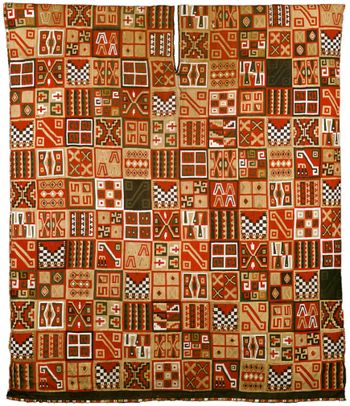Question
thumb_up100%
Describe the Inka textile, All-T’oqapu Tuni and explain its historical significance

Transcribed Image Text:This image showcases a traditional textile composed of a meticulously ordered arrangement of square patterns. The textile features a diverse array of motifs including geometric shapes, stylized figures, and intricate line work. Dominant colors include shades of red, orange, tan, and black, which create a vibrant and cohesive aesthetic.
### Detailed Analysis of Patterns:
- **Geometric Shapes**: Many squares feature repeated geometric patterns such as triangles, diamonds, and squares, often outlined boldly to highlight the shapes.
- **Stylized Figures**: Some segments show stylized antropomorphic or zoomorphic motifs, with designs that might suggest cultural or symbolic meanings.
- **Checkerboard Patterns**: Several squares contain alternating colored squares arranged in a grid, reminiscent of a checkerboard.
- **Spiral and Line Patterns**: Spirals and linear motifs appear frequently, adding a sense of movement and fluidity to the design.
- **Symmetry and Repetition**: There is a clear use of symmetry and repetition across the different squares, indicating a deliberate design choice to create balance and harmony.
Overall, the textile exemplifies traditional craftsmanship, displaying both artistic skill and cultural significance. It serves as an educational piece that can offer insights into historical textile practices and the cultural meanings embedded within these intricate designs.
Expert Solution
This question has been solved!
Explore an expertly crafted, step-by-step solution for a thorough understanding of key concepts.
Step by stepSolved in 3 steps
